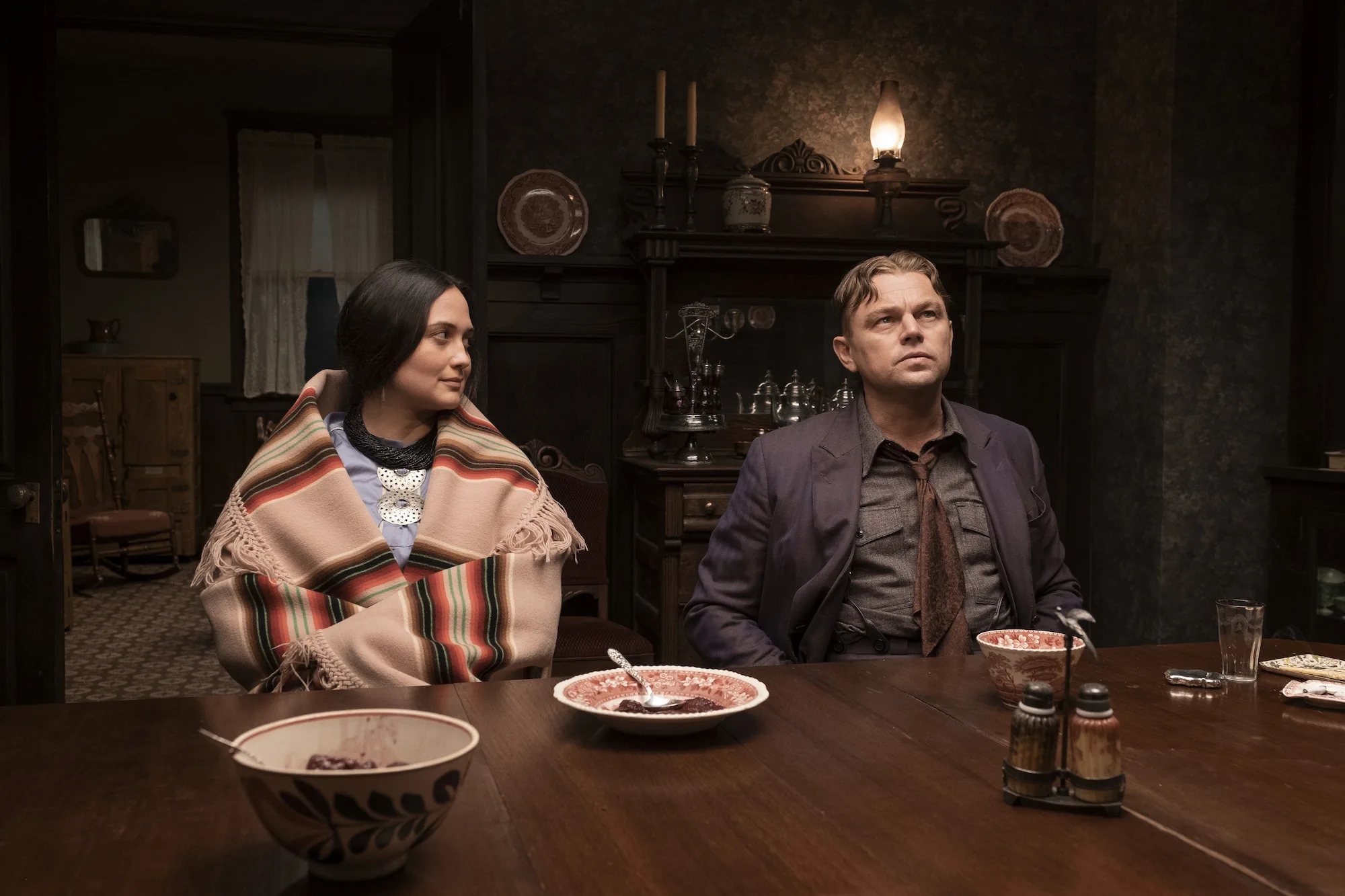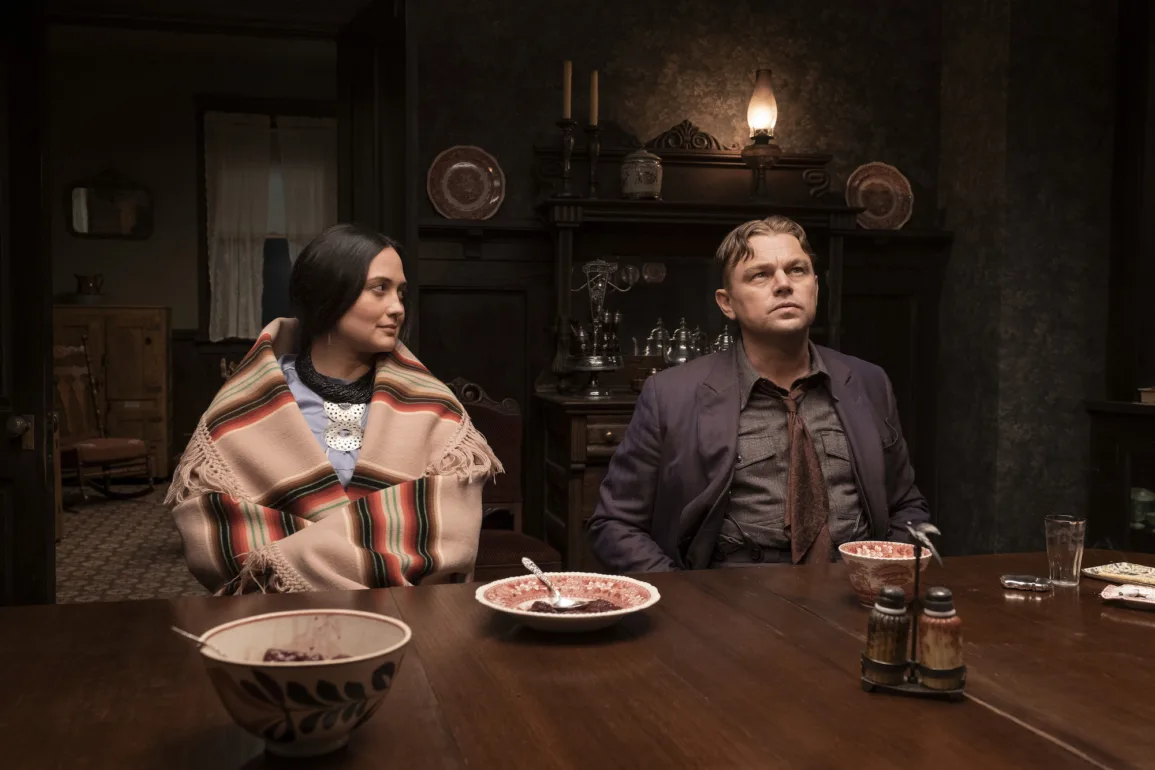
It’s become even more of a given in our present era that there exists two justice systems, which overlap but all too often apply differently to people based not on criminal wrongdoing but on the “pre-existing conditions” of race, class and privilege. One can readily understand the disbelief of Trump, his cronies, and insurrectionists in facing prosecution, even potential prison sentences—folks like them generally don’t suffer consequences for illegal actions, or get a wrist-slap. We can’t help but be a bit amazed whenever a wealthy, well-connected white perp actually goes down, because so frequently the system manages to work in their favor. That same system also tends to go soft when crimes are perpetrated on “other” people, those not particularly privileged in terms of race, class or connections.
You could hardly find a more grotesque US historical example of that than the one dramatized in Martin Scorsese’s new film, Killers of the Flower Moon. Based on David Grann’s bestselling 2017 nonfiction tome of the same name, it’s a rehash of a very dark chapter in our nation’s 20th century that ought to be more widely known than it’s been for the ensuing hundred years or so.
Uprooted from their traditional lands in the Missouri Territory by the US government early in the 19th century, the Osage people eventually purchased their own approximately 1.5 million-acre reservation in north-central Oklahoma. The area was chosen in part because it was not expected to become desirable to white settlers. In 1894, however, oil was discovered. As fossil fuel needs skyrocketed with the rise of the automobile, tribal members became very wealthy from the royalties generated by their mineral rights.
This created some lives of conspicuous consumption as well as Wild West, gold-rush-style boom towns. It also attracted outsiders who hoped to cash in, whether by working the oil fields, catering to this nouveau rich populace… or marrying into their ranks. The bottom feeders simply robbed them. Some enterprising souls managed all of the above.
Eric Roth and Scorsese’s screenplay opens around the close of World War I. Ernest Burkhart (Leonardo DiCaprio) is just another soldier returning to civilian life from service on the European battlefront—though he was just an Army cook. He’s arrived in small yet crazily energetic Fairfax, OK to seek employment, leaning on the generosity and knowhow of his uncle William King Hale (Robert De Niro), a bigwig hereabouts.
In fact, the latter is the so-called “King of the Osage,” having wormed his way into the tribal council’s confidence, to their mutual profit. It’s not long before Ernest is profiting off that association, too, pitching woo to Mollie (Lily Gladstone), who like her sisters and mother is a “fullblood” with a considerable oil-industry income stream. He’s not the first white man in the area to get a grip on that wealth by putting a wedding ring on it. While demonstrably none too bright, however, he does have one distinguishing characteristic: Much as he confesses to love money, Ernest also appears to genuinely love his wife.
All of which would be nice, if Osage Nation peoples didn’t simultaneously seem to be dying left and right, by means that vary from the respectably murky (“wasting illness”) to point-blank-gunfire murder. Even the latter incidences somehow never seem to get properly investigated, let alone the killers brought to justice—something one suspects gladhanding William (who pulls puppet strings on the local police and courts) has more than a little to do with. Mollie’s own kin get whittled down until she’s the last one standing, every death increasing her share of the fortune. Soon she’s not standing so well, either, as the medicine administered for her diabetes seems to be working the opposite of a cure.
Amidst this epidemic of suspicious deaths, tribal leaders reach out in desperation to Washington DC. (As we’ve seen, private detectives and others hired privately by the Osage to solve the mystery seem to suffer premature demises themselves.) This results in the eventual arrival of a Federal agent (Jesse Plemons), representing what would soon become the FBI. His inquiries cannot be dismissed or disposed of so easily. They also quickly reveal that while the Burkharts & co. may have been smart enough to get away so far with a homicidal spree in rural Oklahoma, they are by no means clever enough to hide it from persistent, badge-carrying, well-armed outsiders.
Sponsored link
In real life, the number of primarily Native American people who died during a “Reign of Terror” lasting roughly the entire Roaring Twenties has been estimated as anywhere from sixty to “in the hundreds.” The obvious goal was to transfer land and mineral-rights wealth to white ownership, with insurance scams adding to the pot o’ stolen gold. If William Burkhart was this elaborate, ever-evolving scheme’s mastermind, he was hardly its only villain.
Justice did ultimately descend upon these upstanding if ruthless citizens. Yet both leading male figures here got pardoned some way into their supposed “life sentences,” living at liberty to the ripe old ages denied their victims—albeit in much-diminished financial circumstances.
It’s a mind-boggling story of civic benevolence masking bloodthirsty covetousness. If it’s also to an extent another tale of organized crime, at least it sets Scorsese in fresh cultural terrain he seems stimulated by, which is a relief after 2019’s The Irishman found his East Coast mob fixation starting to feel a bit arthritic.
Killers of the Flower Moon is just as long as that film, almost 3.5 hours, and while it becomes steadily engrossing after a leisurely start, it would be false to claim this movie fully justifies that sprawl. (One can easily imagine a tighter script lending it just as much or more punch within a two-hour frame.) Given so much time, it’s puzzling how many narrative puzzle-pieces never quite get filled in—particularly in terms of the leading male characters’ psychology. We get that Ernest is something of a dolt, a quality DiCaprio thoroughly enjoys illustrating. But the film never even tries to get a handle on how he might truly love his spouse and at the same time be kinda OK with poisoning her.
Likewise, De Niro presents a sociopathic titan who never lets the mask of gentleman-farmer obseqiousness drop. Is this tack meant to underline the banality of evil? Evil is clearly there in William’s deeds, yet we never flat-out see it. These and other under-realized elements make the film feel spotty and incomplete in important ways, even as it nonetheless grips our attention.
At the same time, whatever conceptual limitations they’re saddled with, these actors are working near the top of prodigious skillsets. Gladstone (from recent Kelly Reichardt features) is their match. She’s got the depth of presence to render Mollie’s docile opacity more intriguing than frustrating, however much we wonder why she doesn’t bolt a perilous situation much sooner. While Scorsese’s portrayal of Osage culture feels more outside-in and pageantry-oriented than his depiction of the predatory whites, he’s cast every small role and background player with an unerring eye for period veracity that’s echoed in all production-design details.
I could have done without the parade of too-familiar faces (notably John Lithgow and Brendan Fraser) that arrive late to juice up the courtroom scenes—they’re a hammy distraction. But for all its flaws, Killers still offers the satisfactions of a great big Hollywood prestige project done right, telling a story so jaw-dropping you can’t quite believe it happened in the “land of the free.” Of course, the fact that it’s remained so under-radar (like the 1921 Tulsa “race riot” also referenced here) in long decades since is one way in which that all-American myth of equal-opportunity justice and prosperity remained intact. Killers of the Flower Moon expands to theaters nationwide this Fri/20.
You might well think, “Well, at least such blatant criminal theft and bigotry wouldn’t happen today.” Pricking that balloon is Raoul Peck’s new documentary Silver Dollar Road, which begins streaming on Amazon Prime Oct. 20. This is another alarming tale of real-life injustice whose roots go back a century or more. In 1911, one Elijah Reels purchased sixty-five acres in Carteret County on North Carolina’s eastern coast. Sixty years later a descendent died without leaving a will, so the property passed to a group of heirs. One of them fraudulently sold nearly all the prime waterfrontage without informing anyone else in the family.
They had the deeds, permits, etc. to prove that sale was invalid. Yet presumably because the Reels are African Americans in an area that’s steadily escalated in gentrification and real estate value since, somehow the dispute has continually dragged through the courts, which keep deciding against them. It culminated in two Reels going to prison for “trespassing” on the land they’d always lived on, in the homes they’d built. How can that even be? Well, as one lawyer here puts it, “The elephant in the room is race.”
Silver Dollar Road is based on a ProPublica story that was also published in The New Yorker. It explains much of a very tangled legal history that Peck doesn’t bother with. That makes this film considerably less illuminating than some of the veteran director’s many prior ones, such as 2016 James Baldwin portrait I Am Not Your Negro. It would be nice if we heard something/anything from opposition camps, although one imagines they politely (and/or litigiously) declined to participate. Don’t go thinking those coveting the land have disdained low tactics, however: Professional fisherman Melvin Reels’ boat was blown up, a house set afire, and so forth. When the filmmakers try to contact the official current owners, “they” turn out to be a shadowy corporate entity whose court-listed phone number is disconnected.
The Reels just want to retain the one good thing that’s been in the family as long as any of them can remember, a place of natural tranquility and relaxation. But that is something their neighbors and even the state apparently think they no longer “deserve.” As in Killers, the unspoken logic seems to be that “those people” don’t deserve something nice…certainly not if anybody “respectable” now wants it. Silver Dollar Road is not great nonfiction storytelling, leaving a slew of questions dangling in its way. Yet it’s potent enough nonetheless to make your blood boil a bit.


